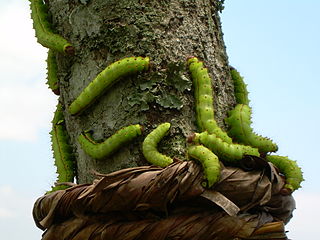Related Research Articles

Saturniidae, members of which are commonly named the saturniids, is a family of Lepidoptera with an estimated 2,300 described species. The family contains some of the largest species of moths in the world. Notable members include the emperor moths, royal moths, and giant silk moths.

Bombyx is the genus of true silk moths or mulberry silk moths of the family Bombycidae, also known as silkworms, which are the larvae or caterpillars of silk moths. The genus was erected as a subgenus by Carl Linnaeus in his 10th edition of Systema Naturae (1758).

Saturnia is a genus of large moths in the family Saturniidae, which the German biologist Franz Paula von Schrank first described in 1802. Its members are commonly named emperor moths, though this is also used for various close relatives in subfamily Saturniinae. Most species are Palearctic, but three, commonly called saturnia moths, inhabit the chaparral of California: S. mendocino, S. walterorum, and S. albofasciata.

Caligula is a genus of moths of the family Saturniidae. It is primarily an Oriental genus, found in India, China and Southeast Asia. The genus is often treated as a synonym of Rinaca. It is named after Roman emperor Caligula.

The Saturniinae or saturniines are a subfamily of the family Saturniidae. They are commonly known as emperor moths or wild silk moths. They are easily spotted by the eyespots on the upper surface of their wings. Some exhibit realistic eye-like markings, whilst others have adapted the eyespots to form crescent moon or angular shapes or have lost their wing scales to create transparent windows. They are medium to very large moths, with adult wingspans ranging from 7.5 to 15 cm, in some cases even more. They consist of some of the largest sized Lepidoptera, such as the luna moth, atlas moth, and many more. The Saturniinae is an important source of wild silk and human food in many different cultures.

Wild silks have been known and used in many countries from early times, although the scale of production is far smaller than that from cultivated silkworms. Silk cocoons and nests often resemble paper or cloth, and their use has arisen independently in many societies.

Rinaca is a genus of moths in the family Saturniidae erected by Frederic Moore in 1862. It is often treated as a subgenus of Saturnia.
References
- Hampson, G.F. et al. (1892–1937) Fauna of British India Including Ceylon and Burma - Moths. Vols. 1-5 cxix + 2813 p - 1295 figs - 1 table - 15 pl (12 in col.)
- Savela, Markku. Website on Lepidoptera and Some Other Life Forms - page on family Saturniidae (Accessed 8 July 2007).

